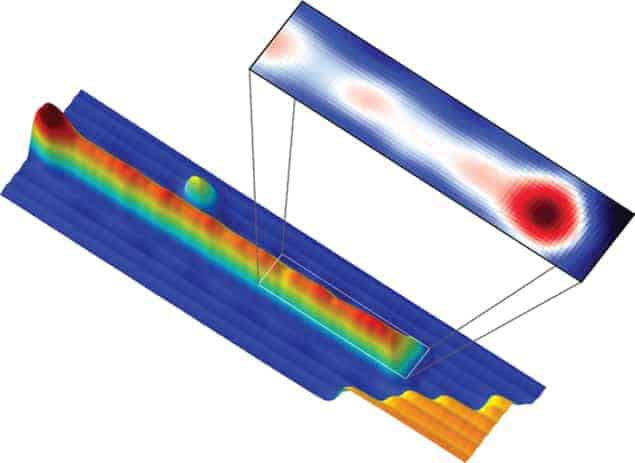
The strongest evidence yet that Majorana quasiparticles (MQPs) can be found lurking in some solids has been unveiled by physicists in the US. The team used a scanning tunnelling microscope (STM) to locate MQPs at the ends of atomic chains of magnetic iron lying on the surface of a lead superconductor. MQPs have special properties that could make them ideal for use in quantum computers, and this latest breakthrough could lead to practical devices that make use of the quasiparticles.
First predicted by the Italian physicist Ettore Majorana in 1937, the Majorana fermion has zero charge and is its own antiparticle. Unlike conventional fermions such as the electron – which obey Fermi–Dirac statistics – the Majorana fermion obeys “non-Abelian” statistics. This means that quantum information encoded in the particles would be highly resistant to decoherence. Decoherence is the bane of physicists who are trying to develop practical quantum computers, and therefore devices based on Majorana fermions could be used in future quantum-information systems.
Exciting excitations
Although Majorana fermions have never been spotted as free particles, there is growing evidence that collective excitations of electrons – called quasiparticles – in some solids can have the same properties as Majorana fermions. Evidence of such MQPs has already been seen at the interface between a superconductor and a non-superconductor in several different experiments – however none of these studies have been conclusive.
Now, Ali Yazdani and colleagues at Princeton University and the University of Texas at Austin have found further evidence of MQPs at the interface of a superconductor and a magnet. The team looked at magnetic chains of iron atoms on the surface of a superconducting lead crystal that is chilled to 1.4 K. Using a spin-polarized tip on their STM, the researchers were able to show that the iron chain is ferromagnetic. Then, using the STM to measure the energy spectrum of electrons in the chain, they showed that the iron was also behaving as a superconductor – a phenomenon known as the proximity effect.
Swirling electrons
The superconductivity in the iron chain involves paired electrons travelling in helical orbits. This rare type of pairing makes the chain a “topological superconductor”, and MQPs are expected to occur at the end of the chains.
To locate MQPs, the team looked for something called a zero bias peak (ZBP) in the electron energy spectrum of the iron chain. The STM measures the ease with which an electron can be added or removed from the chain by applying a bias voltage between the tip and the chain. However, because the MQPs are a combination of a negative particle and a positive antiparticle, they can only move in and out of the chain when a zero applied voltage – or bias – is applied at the tip.
The team scanned the STM tip along a chain, and found the expected ZBPs at either end. But the ZBP could be due to an unrelated magnetic resonance that can occur in the chains. This was ruled out by repeating the measurement in a weak magnetic field, which stops lead from being a superconductor. The ZBP vanished as expected. If the ZBP was related to a magnetic resonance, it would have been enhanced by the magnetic field, not diminished.
Mobile Majoranas
While the physicists are not alone in seeing ZBPs at the ends of tiny wires, they are the first to be able to rule out the effect of magnetic resonances. Yazdani told physicsworld.com that the team is now studying edges of 2D islands of magnetic atoms on a superconductor for evidence of MQPs. Such MQPs should be able to move along the edge of an island, allowing physicists to further study their properties.
Joel Moore of the University of California Berkeley sees the work as a significant contribution to MQP research: “It goes beyond the previous efforts also seeing zero-bias tunnelling peaks in that it has excellent spatial resolution and a clearly defined system that can probably be reproduced by other groups.”
However, Moore points out that for MQPs to be useful in quantum computers, their non-Abelian nature must be established – something Yazdani and colleagues are also working on at the moment.
The video below shows how the iron chains were made and studied using STM.
The research is described in Science.



